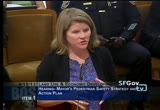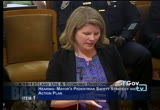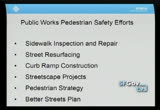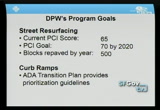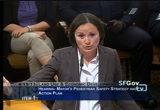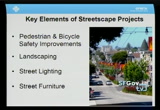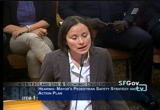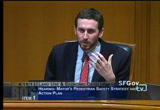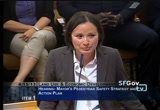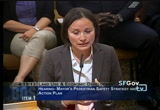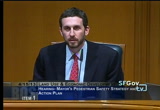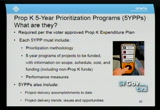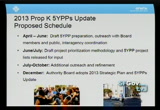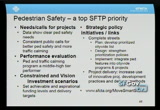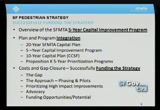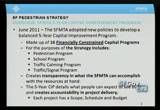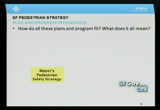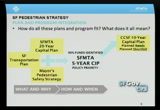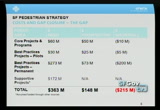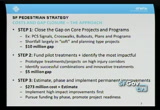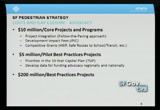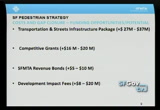tv [untitled] April 22, 2013 9:14am-9:44am PDT
9:14 am
>> i think tim can correct me if i am wrong and i think the numbers came from a combination of the need, what we're doing now and understanding the need and taking those into account to come up with the recommendation so i think it is based on trying to hit everywhere that we need a head count but we have a prioritization method of figuring out in what order. >> also i notice there are two areas that we're going to prioritize where seniors maybe hit more than other parts of the cities and have we identified those two senior areas already? >> have you identified the senior areas already? >> [inaudible] >> okay. >> what are the two areas? >> it's two annually. is that right? >> yes. >> okay. >> it's really focused around the senior centers just like prioritizing schools and looking at where the senior centers are and dealing with two of them every year. >> okay. i want to make sure
9:15 am
because we had so much process already and i don't want to create more processes that we determined the number and have another process to determine what those numbers look like or where they are when i think we already have so much data all right. thank you. >> good afternoon supervisors. i am christine olaila and a project manager and i lead the street scape team for department of public works. dpw is aware of its keen role in implementing the pedestrian strategy by designing and constructing a lot of the improvements that are recommended by the strategy. our pedestrian safety efforts fall into three categories. first maintenance, second, enhancement, and helping the city develop policy so under maintenance we have the sidewalk inspection and repair program and as well as the street
9:16 am
resurfacing. we add enhancement through repaving. the curb enhancement program and the screet scape program. in developing city policy we were participants in the citizen strategy as well as the better streets plan. in addition to federal and state grants and prop k funding our primary source of funding for the next three-five years is the 2011 road repaving and safety bond. this is a break down of the funding and you can see there is $50 million that was specifically for street scape, pedestrian and bicycle safety. the projects have been selected for that money but the pedestrian high injury corridors were used to help select those projects. it was also the first time we did follow the paving effort where we looked at streets being repaved that fell
9:17 am
on the pedestrian and high injury corridor map and included improvements, not only for pedestrians but for bicycles as part of that. we also worked closely with mta and city planning in developing those projects.dpw's schedule is driven by our goals. for repaving the goal is up to 70 by the tweer 2020 and current leer we're at 65 and we're are trying to make sure to hit that target in about seven years from now. our ramp program uses the ada transition plan to help prioritize locations. the focus is on requests from the disabled, access to public facilities, and transit routes.
9:18 am
we also recently started adding bulb outs to the projects and the first is geary boulevard and worked with mta with what intersection were getting ramps as part of the plan and add curb bulbs to that project. >> and specific to that and i don't know if you heard my opening remarks. is that evaluation -- my understanding that is happening city wide and a couple of districts and we were disappointed that it happened without the evaluation. >> i heard your opening statement. we are coordinating with the mta. the challenge is having a steady funding source. there is no funding for that. we have a capital request for that but that is the regular challenge having regular funding. >> i know there could be
9:19 am
funding challenges or after it's analyzing a bulb out doesn't work. i think it's personality that we are at. >> >> least asking the question and in my experience dpw it's a very nimble agency in a lot of ways and it's smaller than the mta so things can happen a little more quickly and sometimes dpw to its credit moves quickly and sometimes other agencies are not there yet, so i'm glad to hear there is that broader coordination happening. >> right. with repaving in coordination with the mta look at streets repaved two-three years from now so we're starting the process in advance so it doesn't slow down the repaving schedule. we looked at the next two years as part of the streets bond and the repaving effort so it's now getting ahead of the
9:20 am
eight ball getting to those future projects. >> great thank you. >> so one of the key efforts that will help bring the pedestrian strategy to reality will be coordinating with our street scape projects or our street scape programs. the pedestrian strategy hopes to improve 1 mile a year of high injury corridors with full design large street scape projects. our projects typically include pedestrian and bicycle safety improvements as well as landscaping, street lighting and street furniture and certainly the street lighting helps improve pedestrian safety. in 2012 the board passed an ordinance to help street line the review of the bulb outs and that will help with the projects reduce the cost and reduce the time that is required to get these
9:21 am
improvements approved, and finally i just have a project map for this fiscal year of active street scape projects. you can see they're spread throughout the city. these are great street projects funded by federal and state grants using prop k as a local match and the ones in blue are funded by the street fund and that concludes my presentation. >> just quickly when you say 1 mile per year for the widening and greening and traffic lights, et cetera. do we have a list of where the 1 mile is every year? >> we don't have a list right now. i think the emphasis is the high injury corridors but we need to figure out which mile each year? >> and when will we determine that so the board has a sense of the timeline for the high
9:22 am
priority corridors this year? >> [inaudible] >> early 2014. >> great. thank you. >> in terms of the 1 mile a year goal -- it's certainly better than 0 miles a year but we would love that to be a higher number, and is it -- in terms of -- i know this is formulated by the task force at the mayor's office set up. in terms of the constraints having that be a higher number. i know cost is an issue, but is cost the primary issue or is capacity in terms of staffing? what really is the primary issue or obstacle? >> right. what would it take to get more than a mile. >> yeah. >> i think the pedestrian
9:23 am
strategy states 5 miles a year. it's a mile with higher levels improvements and 4 miles of lower cost improvements, so part of it to go beyond that i think would take a larger investment from our city. the streets bond was a one time in flux of money that will end -- we're going to have the second bond sale and one more after that so i think funding is definitely part of it. with funding would come more resources, staff resources, as well as -- well, i guess staff resources as well, so combination of things that would i think help us get higher or more improvements. >> and i know it's risky to compare us to new york city but new york's program i think is more miles per year. i think -- i have heard they are able to do
9:24 am
some of the things less expensively if that's it than we can. any in sight there why they're able to do it faster and i think cheaper? >>i think new york has done a really good effort at putting their payment to parks program converting unused street space quickly and easily. they're slightly different. they have been able to find the space on one way streets where they did have a lot of extra capacity. streets that didn't have parking to begin with so they were able to claim that space. dpw is looking into efforts to reduce the cost of bulb outs and other improvements, looking at potential temporary improvements. we have done that through the payment to parks and our park programs so it's something that we're actively looking into. >> yeah, my understanding is
9:25 am
also in new york it's much more -- as i asked, there is more of a person in charge. i can't remember her name. >> jeanette. >> yeah. and it just happens and there is coordination and people -- so i think -- again we're not new york city in many, many ways but this is something they have done exceptionally well, and i hope we're trying to learn from them in terms of process improvements as well. >> they're set up differently. jeanette heads the new york dot and like mta and dpw here and as the dot they're able to -- it's just a different set up but they're able to fully design, manage, and maintain their streets within one department so i think here it's important that mta and dpw work together since we're two separate departments
9:26 am
but i think we have a good working relationship through the streets bond and that will continue. also our streets capital group works together. >> i understand they might be merged into one department and we're two and actually more departments than that, but i don't think the happen ns stance of the departmental structure -- i think that could be easily worked around, so i think we should start keeping pace. thank you. >> good afternoon supervisors. i am used to saying commissioners and [inaudible] deputy director for policy and programming with the san francisco transportation authority. i thank you for
9:27 am
having this hearing today. i'm going to focus on prop k in particular which is the half cent sales tax for transportation in san francisco. however, there are a lot of funding programs that are available to address pedestrian safety, and the challenge is how to balance the various opportunities to address it in a strategic manner. is there enough funding? no. but i think we have an opportunity with the strategy to figure out the ways to address the highest need areas in a strategic way. in the past there hasn't been a clear vision how to put together the program of projects so what we're looking for with the five year prioritization programs is moving in the right direction to link transportation investments and the efforts of the
9:28 am
pedestrian safety task force with safety goals and prop k is flexible in that regard. it can fund basically all of the transportation infrastructure improvements that you heard discussed today. tomorrow you have continental walks and safe to routes program and next month curb signals and curb ramps. we leverage federal and state grants for all of these projects so it's a very flexible source and for the categories that are programs, so they're not specific projects like the trans bay terminal or central subway. these are traffic calming, pedestrian crossing and upgrades and require a five year prioritization program, and they these involve -- they require actually. it's in the voter approved expenditure plan that
9:29 am
tray require a methodology for all of the categories and require a five year program of projects and this is for all projects that agencies anticipate requesting funding for over the next five years, and the timing of the release of the strategy is really -- it couldn't be better because we're about to kickoff the process for updating the five year programs at this point, so this is an opportunity for the public to see, for the agencies to coordinate amongst each other, for board members to have insight into what projects are coming down the pipeline, how can we integrate improvements from one project that might draw from other categories to fund the project, so prop k is very flexible in that regard. i will also add that prop k is a 30 year program, but one of the things that we can do is we can
9:30 am
accelerate the availability of prop k funds from the out years of the program to the near term years of the program, so that if there is the capacity and the prioritizing methodology and a list of projects that agencies are ready to implement in the next five years we can recommend through this five year plan update to accelerate the amount of funding that is available. examples for the folks at home of the types of projects that require five year plans are traffic calming, and pedestrian safety signals, and transportation and land use, which is primarily funding large grants. the schedule for updating the five year plans between now and june we will be doing outreach and the agencies will be doing outreach to work amongst each other to prepare
9:31 am
the prioritization parameters, and draft list of projects. outreach will be done and a list will be presented to the board in july, and then additional outreach will take place through october where the public has another opportunity to weigh in on what they would like to see funded in their neighborhood for pedestrian safety improvements with approval by the board in december and more information is available at www. sfgtv .org mta. i will note there is expenditure plans and the 10-dollar registration fee and those register in san francisco pay annually. about 1.2 million is allocated for pedestrian safety improvements annually so that is another funding source that the authority manages and
9:32 am
i do also want to make a plug for www. my street sf. this is a google map application where the public can search for projects in their community, in their specific district, of a type of project. you can search by pedestrian safety projects. it doesn't measure curb ramps or sidewalk repairs because they come to us in a large volume, but it tells you what is under way and you can see how implementation is going and once the five year plan comes in we will up load those so folks can see what is happening in their neighborhood. we are working to update san francisco's long range transportation plan and really the capital improvement program that jonathan will talk about now and the five year plans are really the near term
9:33 am
implementation of san francisco's long-term strategies for improving pedestrian safety in the city. >> good afternoon supervisors. i am jonathan ruers. i'm last in a line of presenters. i am manager of the capital financial planning and long time at mta and the issues i deal with are the issues that you brought up today. we have good plans and strategies like this and how do we implement them and turn them into built projects? i will talk about the tool that the mta use for that. it's a new one, our five year capital improvement program and talk how they're irnlt greatd and we talk about integration between the departments and how does it
9:34 am
work? how do all of the plans and how do they integrate actually getting these things built? and the last thing we do have a gap and there is cost identified in the strategy and how do we close that gap and what are strategies to consider in doing that? quickly the mta's capital improvement program five year plan is a new thing and we start in 2011 and provide a transparent view to the community and we have so many dollars of resources available and what with we do so people would understand that. it's made up 16 contained program and we have a certain revenue in a five year period, let's say $100 million and what can we deliver within the programs. for the purpose of the strategy that includes the
9:35 am
pedestrian cip program and traffic calming program and traffic signal program and this is to provide transparent in what we can do and accountability so within the five year window somebody could see what intersections are we taking care of it and what areas of the city you expect improvements to happen. just our current cip is the fiscal year 13 and through 17cip and includes 350 projects with 30 federal and state and local funds and one being proposition k but there are 140 fund types and those are restrictions on time, type of project and program which means different sources have different rules and sometimes it's difficult to put a package of funding sourcing together for large projects and we take that into consideration. for the current cip -- our
9:36 am
current program is listed here and school program and traffic calming and traffic and signal program and large at 70.6 million and infusion of 25 million from the prop b bond and during this period we're seeing a high use of prop k for delivery and construction projects in the process. >> just so quickly this is all of the dollars available from the pots -- >> the current five year window correct. how does this work and how do these things tie together? a question that people often ask what do the plans mean? how do they fit together? how do you get the projects? here you have the mayor's pedestrian safety strategy and you have the transportation plan that is being completed. we have at the mta a 20 year capital plan that
9:37 am
looks at all of the needs from whoever that is not financially constrainedded and what people want to see on the streets and how they want the transit system to look and one this is a policy priority and second we make it a policy within the agency that we don't add a capital project unless 95% of the funds are identified for the projected that we promise and it's important. that set to the scoping and who do we do with the dollars. that's the what and why of the projects and the cip talks about the how and when and how many years and fund it? that leads to the 10 year capital plan and what we can spend and clifer and our plan short fall so again we know what we can build, what is the short fall, and reef for financially, and it reaches into the five
9:38 am
year plan and how use the sales taxes within that period. we have these priorities versus the constraints. people notice in the strategy there is page 17 if i recall and this is what it says so there are three primary areas of projects looking at. core projects and programs, our best practices programs and pilots and looking at the treatments that are most effective along our corridors, piloting those and which work best and implementing those, so overall plus the support. we have $363 million of need. we think perspectively based on very -- i am stress this,
9:39 am
conservative needs and there are the needs and the constraints. i want to stress again it's based on timing so the constraint is 2021 based on the strategy so if we had another 10 years could we close the gap and come up another couple million dollars? probably but this is again to get the strategy completed within the time frame that we identified. step one close the gap in the programs and those we know are effective and implementing some of the educational programs that we talked about. the short fall, that $10 million short fall is really in the areas of the kind of the plans, education, and outreach because very often the funding sources that we deal with at mta you build the project and deal with this. and these programs are limited to us so that is the $10 million gap. step two, fund pilot treatments
9:40 am
and identify those most impactful so we're building up how to take care of the short fall. one do the injury corridors, identify innovative treatments and integrate with other projects. again that is a $5 million gap. step three and estimate improvements and we estimated the third part, the permanent capital improvements but again this is a strategy. it's a plan. it's an estimate. we haven't actually gone to the intersections. we haven't done the engineering but that is the goal. that's what we're reaching towards so again we want to implement the high impacts first and then pursue funding by phase and i often tell people so they see the total there and we're never going to accomplish that. in reality we want to fund environmental studies, do outreach and fund designs and
9:41 am
those things that can be achieved as things tend to snow ball and it's easier to define other projects and fund the gaps so on the advocacy side here are three areas where we know we have short falls. kind first to close the $10 million. first look to project integration opportunities so the streets bond is a good example and look at alternate source for the programs and one thing at mta we're looking at and implement the large transit improvements can we do other improvements simultaneously and the best practices and in the capital plan for future sources and develop the data
9:42 am
for mtc, to the federal government and state of california as new sources come up and the $200 million and i want to stress this. fund pre-planning and low dollar and makes it easy for people like me why we are ready and have shovel ready projects and something that we can fund. focus on projects to phase over time so i don't want people to get scared with that 273 million-dollar number. remember we want to move it through piecemeal and get it done and projects and treatments are easy for me and you to advocate to get the projects funded. what is the potential? how can we close the gap? >> i know that you have two slides left and i am noting the time and i know many members of the public are waiting to speak and i'm going ask to you rush through the last two slides. >> i can rush. >> this is really important but
9:43 am
i appreciate it. >> absolutely. >> thank you. >> i'm going to go really quick. so where is our potential? right now we project potential on top of what is on the strategy from 56 to $80 million and there is a proposal in the 10 year plan. we project conservatively what we can do in grants. we can probably do better there. the mta and will have another bond issuance and another opportunity and development impact fees and our transportation sustainability fee has a source dedicated towards improvements and the five steps and how can we do it, closing the gap, promoting interdisbraigz and pre-planning and testing the best things and funding projects to phase and looking towards those opportunities.
50 Views
IN COLLECTIONS
SFGTV: San Francisco Government Television Television Archive
Television Archive  Television Archive News Search Service
Television Archive News Search Service 
Uploaded by TV Archive on

 Live Music Archive
Live Music Archive Librivox Free Audio
Librivox Free Audio Metropolitan Museum
Metropolitan Museum Cleveland Museum of Art
Cleveland Museum of Art Internet Arcade
Internet Arcade Console Living Room
Console Living Room Books to Borrow
Books to Borrow Open Library
Open Library TV News
TV News Understanding 9/11
Understanding 9/11